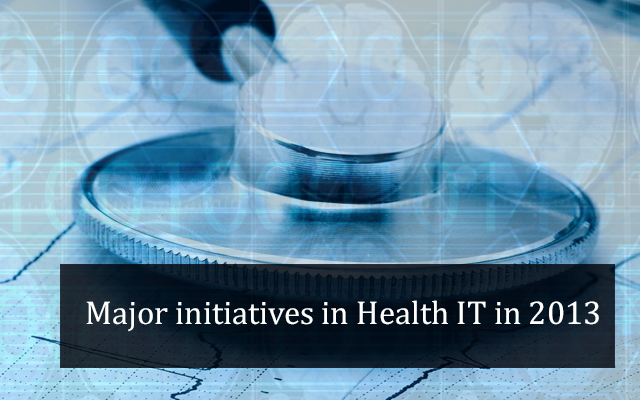As the push for infusing information technology into the healthcare space continues, each year is expected to have its own share of activities and initiatives which get implemented. All of these are finally expected to synergize and lead to a highly efficient and cost effective healthcare system in the future. Each such initiative has a starting time keeping in mind the change it is expected to bring about and the contribution it would make to the system over time. Also, all such initiatives are expected to have certain gestations periods to start offering real benefits. However, the build-up years are bound to result in certain levels of uncertainty and heartburn amongst all concerned stakeholders – owing to major changes affecting the status quo at any point in time.
Year 2013 saw some such Health IT initiatives getting implemented. A few of those were in response to concerns arising on the way and a few with the foresight of where the industry wants to reach. The important wants are as follows:
The HIPAA Omnibus Rule: As an expansion to the Health Insurance Portability and Accountable Act, four new rules have been implemented. Contractors, subcontractors and other business associates of healthcare entities who deal with patient data are now expected to protect it as otherwise a provider would. There are penalties in place as well for cases of non-compliance. Also, how patient information is to be used for marketing purposes and for raising funds have defined guidelines to follow no. In short, no patient information can be sold without the required permission in place. With the digital world in a perennial expansion mode, the new rule is expected to protect patient privacy and safeguard patient health information.
As an expansion to the Health Insurance Portability and Accountable Act, four new rules have been implemented. Contractors, subcontractors and other business associates of healthcare entities who deal with patient data are now expected to protect it as otherwise a provider would. There are penalties in place as well for cases of non-compliance. Also, how patient information is to be used for marketing purposes and for raising funds have defined guidelines to follow no. In short, no patient information can be sold without the required permission in place. With the digital world in a perennial expansion mode, the new rule is expected to protect patient privacy and safeguard patient health information.
Guidance for Mobile Medical Application:
This was provided by the Food and Drug Administration after an almost 2-year wait. The guidelines are enforced only on a certain percentage of apps which pose a threat to patients if they fail to perform what they intend to. Thus, only a small subset of the overall app market falls under its purview. In its current state, the oversight is on all those mobile medical applications which are aimed at being used as accessories to regulated mobile devices or which are likely to transform mobile platforms into regulated medical devices. The agency has been very particular to apply those regulatory standards which it otherwise applies to medical devices. This clarity is also very relevant to the developer community as they build newer and more effective solutions. There were some omissions in the guidelines which include:
- definition of what are regulated i.e. how to determine what requires regulation and what necessitates enforcement discretion
- defining the levels of risk for mobile devices & their accessories
- disease intended uses compared to unregulated, wellness intended uses
- exact meaning of an accessory to a medical device
Meaningful Use Stage 2 deadline extension:
Senators may have asked for a reboot of the system, some senior leaders might have questioned its true benefits; MU is here to stay. However, there is widespread consensus on some of the issues which stand as hurdles in its implementation - with the major one concerning the timeline. As a response to this, CMS proposed Meaningful Stage 2 implementation to be extended through 2016. This will result in the roll out of stage 3 getting pushed to 2017. There has however not been a shift in the start date resulting in drawing flak from some CIOs. They are not convinced about the intent of such a move – that of allowing time for fine tuning for the next stage by extending the deadline and not bring in flexibility in the start date which seems to be the need of the hour. Effectively, it means that those providers who do not start on time will miss out on a payment cycle.
Use of Big Data:
It might be early days for big data usage in healthcare systems; providers who have started using them for their clinical and administrative work have already started noticing the benefits. From reducing mortality rates, bringing down instances of readmission to performing evidence-based budgeting, there are predictions already of saving close to $450 billion in healthcare costs if the right usage of big data is made. People from some sections of the industry are however not overtly excited in jumping to such conclusions although they acknowledge the positives which are visible.
What will be new in 2014? Healthcare testing services would be in demand. Because of the large number of initiatives being rolled out and newer changes affecting healthcare, testing would peak during the year. Certified testing team would help you stay in line with your business goals while ensuring delivery of accurate healthcare solutions.
We provide healthcare software development services. If you would like to hire EMR software developers from us, we would be glad to assist you at Mindfire Solutions.

